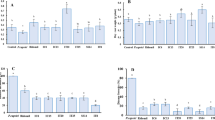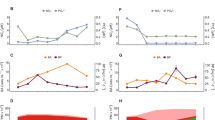Abstract
Petalomonas sphagnophila is a poorly studied plastid-lacking euglenid flagellate living in Sphagnum-dominated peatlands. Here we present a broad-ranging microscopic, molecular and microspectrophotometric analysis of uncultured P. sphagnophila collected from four field locations in Nova Scotia, Canada. Consistent with its morphological characteristics, 18S ribosomal DNA (rDNA) phylogenies indicate that P. sphagnophila is specifically related to Petalomonas cantuscygni, the only other Petalomonas species sequenced to date. One of the peculiar characteristics of P. sphagnophila is the presence of several green-pigmented particles ∼5 μm in diameter in its cytoplasm, which a previously published study suggested to be cyanobacterial endosymbionts. New data presented here, however, suggest that the green intracellular body may not be a cyanobacterium but rather an uncharacterized prokaryote yet to be identified by molecular sequencing. 16S rDNA library sequencing and fluorescence in situ hybridizations show that P. sphagnophila also harbors several other endobionts, including bacteria that represent five novel genus-level groups (one firmicute and four different proteobacteria). 16S rDNA phylogenies suggest that three of these endobionts are related to obligate intracellular bacteria such as Rickettsiales and Coxiella, while the others are related to the Daphnia pathogen Spirobacillus cienkowskii or belong to the Thermoactinomycetaceae. TEM, 16S rDNA library sequencing and a battery of PCR experiments show that the presence of the five P. sphagnophila endobionts varies markedly among the four geographic collections and even among individuals collected from the same location but at different time points. Our study adds significantly to the growing evidence for complex and dynamic protist–bacterial associations in nature.
Similar content being viewed by others
Log in or create a free account to read this content
Gain free access to this article, as well as selected content from this journal and more on nature.com
or
Accession codes
References
Amann RI, Binder BJ, Olson RJ, Chisholm SW, Devereux R, Stahl DA . (1990). Combination of 16s rRNA-targeted oligonucleotide probes with flow cytometry for analyzing mixed microbial populations. Appl Environ Microbiol 56: 1919–1925.
Baker BJ, Hugenholtz P, Dawson SC, Banfield JF . (2003). Extremely acidophilic protists from acid mine drainage host Rickettsiales-lineage endosymbionts that have intervening sequences in their 16S rRNA genes. Appl Environ Microbiol 69: 5512–5518.
Breglia SA, Slamovits CH, Leander BS . (2007). Phylogeny of phagotrophic euglenids (Euglenozoa) as inferred from hsp90 gene sequences. J Eukaryot Microbiol 54: 86–92.
Brenner DJ, Krieg NR, Staley JT (eds) (2005). Bergey's Manual of Systematic Bacteriology, Volume Two: the Proteobacteria. Springer: New York.
Busse I, Patterson DJ, Preisfeld A . (2003). Phylogeny of phagotrophic euglenids (Euglenozoa): a molecular approach based on culture material and environmental samples. J Phycol 39: 828–836.
Dubilier N, Bergin C, Lott C . (2008). Symbiotic diversity in marine animals: the art of harnessing chemosynthesis. Nat Rev Microbiol 6: 725–740.
Fenchel T, Finlay BJ . (1991). Synchronous division of an endosymbiotic methanogenic bacterium in the anaerobic ciliate Plagiopyla frontata Kahl. J Protozool 38: 22–28.
Fenn K, Conlon C, Jones M, Quail MA, Holroyd NE, Parkhill J et al. (2006). Phylogenetic relationships of the Wolbachia of nematodes and arthropods. PLoS Pathol 2: 887–899.
Ferrantini F, Fokin SI, Modeo L, Andreoli I, Dini F, Gortz HD et al. (2009). ‘Candidatus Cryptoprodotis polytropus, a novel Rickettsia-like organism in the ciliated protist Pseudomicrothorax dubius (Ciliophora, Nassophorea). J Eukaryot Microbiol 56: 119–129.
Fokin SI, Schweikert M, Gortz HD, Fujishima M . (2003). Bacterial endocytobionts of Ciliophora. Diversity and some interactions with the host. Eur J Protistol 39: 475–480.
Fokin SI . (2004). Bacterial endocytobionts of ciliophora and their interactions with the host cell. Int Rev Cytol 236: 181–249.
Gorham E. (1991). Northern peatlands: role in the carbon cycle and probable responses to climatic warming. Ecol Appl 1: 182–195.
Hirose E, Uchida H, Murakami A . (2009). Ultrastructural and microspectrophotometric characterization of multiple species of cyanobacterial photosymbionts coexisting in the colonial ascidian Trididemnum clinides (Tunicata, Ascidiacea, Didemnidae). Eur J Phycol 44: 365–375.
Horn M, Wagner M . (2004). Bacterial endosymbionts of free-living amoebae. J Eukaryot Microbiol 51: 509–514.
Jurand A . (1961). An electron microscope study of food vacuoles in Paramecium aurelia. J Protozool 8: 125–130.
Kim E, Archibald JM. (2009). Diversity and evolution of plastids and their genomes. In: Sandelius AS, Aronsson H (eds). The Chloroplast: Interactions with the Environment. Springer-Verlag: Berlin, pp 1–39.
Leander BS, Esson HJ, Breglia SA . (2007). Macroevolution of complex cytoskeletal systems in euglenids. Bioessays 29: 987–1000.
Leclerque A . (2008). Reorganization and monophyly of the genus Rickettsiella: all in good time. Appl Environ Microbiol 74: 5263–5264.
Leedale GF, Vickerman K . (2000). Phylum Euglenozoa. In: Lee JJ, Leedale GF, Bradbury P (eds). The Illustrated Guide to the Protozoa 2 edn Society of Protozoologists: Lawrence, pp 1135–1185.
Loy A, Arnold R, Tischler P, Rattei T, Wagner M, Horn M . (2008). probeCheck—a central resource for evaluating oligonucleotide probe coverage and specificity. Environ Microbiol 10: 2894–2898.
Maddison DR, Maddison WP . (2001). MacClade 4: Analysis of Phylogeny and Character Evolution. Sinauer Associates Inc.: Sunderland, Massachusetts.
Moya A, Pereto J, Gil R, Latorre A . (2008). Learning how to live together: genomic insights into prokaryote–animal symbioses. Nat Rev Genet 9: 218–229.
Muhling M, Woolven-Allen J, Murrell JC, Joint I . (2008). Improved group-specific PCR primers for denaturing gradient gel electrophoresis analysis of the genetic diversity of complex microbial communities. ISME J 2: 379–392.
Murakami A, Miyashita H, Iseki M, Adachi K, Mimuro M . (2004). Chlorophyll d in an epiphytic cyanobacterium of red algae. Science 303: 1633.
Nubel U, GarciaPichel F, Muyzer G . (1997). PCR primers to amplify 16S rRNA genes from cyanobacteria. Appl Environ Microbiol 63: 3327–3332.
Park DJ, Dastager SG, Lee JC, Yeo SH, Yoon JH, Kim CJ . (2007). Shimazuella kribbensis gen. nov., sp nov., a mesophilic representative of the family Thermoactinomycetaceae. Int J Syst Evol Micr 57: 2660–2664.
Pannebakker BA, Loppin B, Elemans CPH, Humblot L, Vavre F . (2007). Parasitic inhibition of cell death facilitates symbiosis. Proc Natl Acad Sci USA 104: 213–215.
Parniske M . (2000). Intracellular accommodation of microbes by plants: a common developmental program for symbiosis and disease? Curr Opin Plant Biol 3: 320–328.
Pugh AL, Norton SA, Schauffler M, Jacobson GL, Kahl JS, Brutsaert WF et al. (1996). Interactions between peat and salt-contaminated runoff in Alton Bog, Maine, USA. J Hydrol 182: 83–104.
Rasolomampianina R, Bailly X, Fetiarison R, Rabevohitra R, Bena G, Ramaroson L et al. (2005). Nitrogen-fixing nodules from rose wood legume trees (Dalbergia spp.) endemic to Madagascar host seven different genera belonging to alpha- and beta-Proteobacteria. Mol Ecol 14: 4135–4146.
Rodrigues JLM, Duffy MA, Tessier AJ, Ebert D, Mouton L, Schmidt TM . (2008). Phylogenetic characterization and prevalence of ‘Spirobacillus cienkowskii,’ a red-pigmented, spiral-shaped bacterial pathogen of freshwater Daphnia species. Appl Environ Microbiol 74: 1575–1582.
Rydin H, Jeglum JK . (2006). The Biology of Peatlands. Oxford University Press Inc.: New York.
Schmitz-Esser S, Toenshoff ER, Haider S, Heinz E, Hoenninger VM, Wagner M et al. (2008). Diversity of bacterial endosymbionts of environmental Acanthamoeba isolates. Appl Environ Microbiol 74: 5822–5831.
Schnepf E, Schlegel I, Hepperle D . (2002). Petalomonas sphagnophila (Euglenophyta) and its endocytobiotic cyanobacteria: a unique form of symbiosis. Phycologia 41: 153–157.
Six C, Joubin L, Partensky F, Holtzendorff J, Garczarek L . (2007). UV-induced phycobilisome dismantling in the marine picocyanobacterium Synechococcus sp. WH8102. Photosynthesis Res 92: 75–86.
Swanson MS, Hammer BK . (2000). Legionella pneumophila pathogenesis: a fateful journey from amoebae to macrophages. Annu Rev Microbiol 54: 567–613.
Swofford DL . (2003). PAUP*. Phylogenetic Analysis Using Parsimony (*and Other Methods), 4.0 edn. Sinauer Associates Inc.: Sunderland, Massachusetts.
Turunen J, Tomppo E, Tolonen K, Reinikainen A . (2002). Estimating carbon accumulation rates of undrained mires in Finland—application to boreal and subarctic regions. Holocene 12: 69–80.
Wernegreen JJ . (2005). For better or worse: genomic consequences of intracellular mutualism and parasitism. Curr Opin Genet Dev 15: 572–583.
Werren JH, Baldo L, Clark ME . (2008). Wolbachia: master manipulators of invertebrate biology. Nat Rev Microbiol 6: 741–751.
Wieder RK, Vitt DH (eds) (2006). Boreal Peatland Ecosystems. Springer: Berlin.
Wolf E, Schussler A . (2005). Phycobiliprotein fluorescence of Nostoc punctiforme changes during the life cycle and chromatic adaptation: characterization by spectral confocal laser scanning microscopy and spectral unmixing. Plant Cell Environ 28: 480–491.
Yassin AF, Hupfer H, Klenk HP, Siering C . (2009). Desmospora activa gen. nov., sp nov., a thermoactinomycete isolated from sputum of a patient with suspected pulmonary tuberculosis, and emended description of the family Thermoactinomycetacea Matsuo et al. 2006. Int J Syst Evol Micr 59: 454–459.
Yoon JH, Kim IG, Shin YK, Park YH . (2005). Proposal of the genus Thermoactinomyces sensu stricto and three new genera, Laceyella, Thermoflavimicrobium and Seinonella, on the basis of phenotypic, phylogenetic and chemotaxonomic analyses. Int J Syst Evol Micr 55: 395–400.
Yubuki N, Edgcomb VP, Bernhard JM, Leander BS . (2009). Ultrastructure and molecular phylogeny of Calkinsia aureus: cellular identity of a novel clade of deep-sea euglenozoans with epibiotic bacteria. BMC Microbiol 9: 16.
Acknowledgements
This study was supported by postdoctoral fellowships to EK and JSP from the Centre for Comparative Genomics and Evolutionary Bioinformatics at Dalhousie University and the Tula foundation; an operating grant (ROP85016) awarded to JMA from the Canadian Institutes of Health Research (CIHR) regional Partnership Program, together with the Nova Scotia Health Research Foundation (NSHRF); NSERC Grant 298366-04 awarded to AGBS; Research Program of Hayama Center for Advanced Studies of Sokendai to SM; and Grant-in-Aid for Creative Scientific Research 17GS0134 from the Japan Society for the Promotion of Science to AM. We thank D Spencer and J Hopkins for help with sample collection, S Whitefield for assistance with light microscopy and P Colp for help with paraffin embedding and sectioning. B Leander is also thanked for assistance with interpretation of electron micrographs. JMA and AGBS are Fellows of the Canadian Institute for Advanced Research, Program in Integrated Microbial Biodiversity, and JMA is a Canadian Institutes of Health Research New Investigator.
Author information
Authors and Affiliations
Corresponding authors
Additional information
Supplementary Information accompanies the paper on The ISME Journal website
Rights and permissions
About this article
Cite this article
Kim, E., Park, J., Simpson, A. et al. Complex array of endobionts in Petalomonas sphagnophila, a large heterotrophic euglenid protist from Sphagnum-dominated peatlands. ISME J 4, 1108–1120 (2010). https://doi.org/10.1038/ismej.2010.40
Received:
Revised:
Accepted:
Published:
Issue date:
DOI: https://doi.org/10.1038/ismej.2010.40
Keywords
This article is cited by
-
“Candidatus Intestinibacterium parameciiphilum”—member of the “Candidatus Paracaedibacteraceae” family (Alphaproteobacteria, Holosporales) inhabiting the ciliated protist Paramecium
International Microbiology (2023)
-
Bodo saltans (Kinetoplastida) is dependent on a novel Paracaedibacter-like endosymbiont that possesses multiple putative toxin-antitoxin systems
The ISME Journal (2021)
-
Detection of novel Chlamydiae and Legionellales from human nasal samples of healthy volunteers
Folia Microbiologica (2015)



